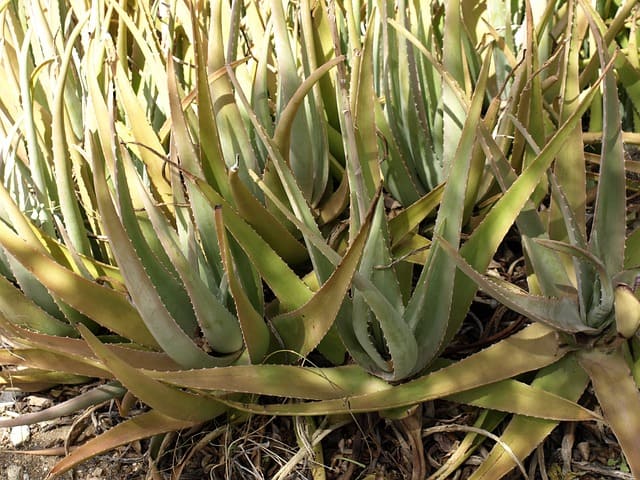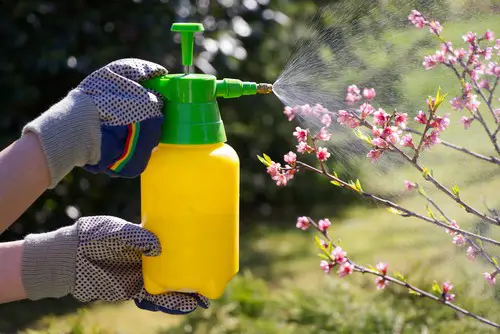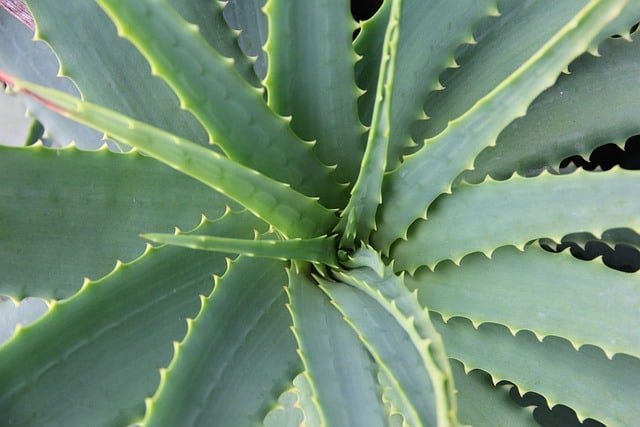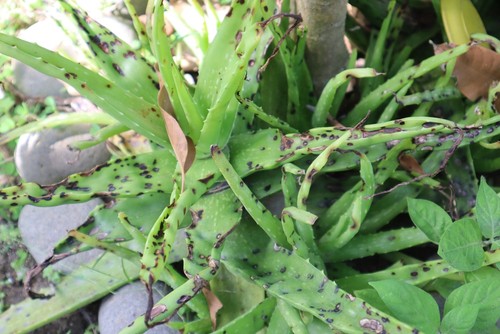Aloe vera plants are a popular choice for indoor and outdoor gardening due to their low maintenance and numerous health benefits. However, one common problem that aloe vera plant owners encounter is the appearance of black spots on the leaves. Black spots can be alarming and may indicate a serious problem with the plant’s health.
Identifying the cause of black spots on aloe vera leaves is crucial in determining the appropriate treatment and management approach. Several factors can contribute to the development of black spots, including overwatering, fungal infections, insect infestations, and environmental stressors.
Understanding the root cause of the problem can help prevent the occurrence of black spots in the future and ensure the plant’s overall health and longevity.
Key Takeaways
- Black spots on aloe vera leaves can indicate a serious problem with the plant’s health.
- Identifying the root cause of black spots is crucial in determining the appropriate treatment and management approach.
- Preventing the occurrence of black spots through proper care and maintenance can ensure the plant’s overall health and longevity.
See these other top posts in this category:
Identifying Black Spots on Aloe Vera Leaves

Aloe vera plants are popular houseplants known for their medicinal properties. However, they are vulnerable to various problems, including black spots on their leaves. These black spots can be caused by several factors, including insects, overwatering, and fungal or bacterial infections.
The black spots on aloe vera leaves are usually circular or irregular in shape and can range in size from small dots to large patches. They can appear on the upper or lower surface of the leaves, and they may be accompanied by other symptoms, such as yellowing or browning of the leaves.
One of the most common causes of black spots on aloe vera leaves is insect infestation. Insects such as mealybugs, scale insects, and spider mites secrete a sugary substance called honeydew, which attracts other insects like ants. The honeydew can also promote the growth of sooty mold, a black fungus that can cause black spots on the leaves.
Overwatering can also cause black spots on aloe vera leaves. When the soil is constantly wet, it can lead to root rot, which can affect the health of the plant and cause black spots on the leaves. In addition, high humidity levels can also contribute to the development of black spots on aloe vera leaves.
Fungal and bacterial infections can also cause black spots on aloe vera leaves. These infections can be caused by a variety of pathogens, including Alternaria, Colletotrichum, and Xanthomonas. Symptoms of these infections can include black spots on the leaves, as well as other symptoms like wilting, yellowing, or browning of the leaves.
Black Spots on Aloe Vera Leaves – 6 Common Problems
Black spots on aloe vera leaves can be a sign of various issues affecting the plant’s health. Gardeners need to identify the underlying cause of the problem to take the appropriate corrective measures. Here are some of the most common causes of black spots on aloe vera leaves:
1. Overwatering
Overwatering is one of the most common causes of black spots on aloe vera leaves. When the soil remains damp for too long, the roots begin to rot, and the plant can no longer absorb nutrients and water from the soil. This can lead to wilting leaves, yellowing, and eventually, black spots.
2. Leaf Spot Disease
Leaf spot disease is a fungal disease caused by Alternaria alternata that destroys the plant’s antimicrobial defense, leading to visible black spots on the aloe’s leaves. This fungus thrives in warm, humid conditions and can spread quickly to other plants. Gardeners must isolate and dispose of infected plants to prevent the spread of the disease.
3. Fungal Infections
Fungal infections like soft rot, basal stem rot, and sooty mold can cause black spots on aloe vera leaves. These infections are caused by fungi that thrive in damp conditions and can be spread through contaminated soil, water, or air. Gardeners must treat infected plants with fungicides and improve growing conditions to prevent reoccurrence.
4. Pests
Pests like mealybugs, scale, and aphids can secrete honeydew, a sugary substance that attracts ants and other insects. The feasting process damages the plant, eventually resulting in black spots. Gardeners must use pesticides or rubbing alcohol to eliminate pests and improve growing conditions to prevent reoccurrence.
5. Sunburn and Winter Stress
Aloe vera plants require bright, indirect sunlight to thrive. Direct sunlight can cause sunburn, leading to black spots on the leaves. During the cold season, aloe vera plants may experience winter stress, leading to wilting leaves, dry soil, and black spots. Gardeners must provide proper shade and growing conditions to prevent sunburn and winter stress.
6. Potting Mix and Container Issues

Improper potting mix and container issues can cause black spots on aloe vera leaves. Plastic pots with no drainage holes can cause water to accumulate in the soil, leading to root rot and black spots.
Glazed pots can also cause water to accumulate, leading to a lack of oxygen and nutrients for the plant. Gardeners must use a well-draining potting mix and containers with proper drainage holes to prevent potting mix and container issues.
Preventing the Occurrence of Black Spots
To prevent the occurrence of black spots on aloe vera leaves, it is important to maintain a healthy plant. Aloe vera plants that are healthy are less likely to be affected by problems such as pests, diseases, and black spots.
One of the key factors in maintaining a healthy aloe vera plant is sunlight. Aloe vera plants require plenty of sunlight to grow and thrive.
They should be placed in a location that receives at least six hours of direct sunlight each day. In the summer months, it is important to protect the plant from the harsh midday sun, as this can cause the leaves to become scorched.
Temperature is another important factor in preventing black spots on aloe vera leaves. The ideal temperature range for aloe vera plants is between 60 and 75 degrees Fahrenheit. If the temperature drops below 50 degrees Fahrenheit, the plant may become dormant and stop growing.
On the other hand, if the temperature rises above 90 degrees Fahrenheit, the plant may become stressed and more susceptible to problems such as black spots.
Another way to prevent black spots on aloe vera leaves is to address pest problems promptly. Insects such as mealybugs, scales, and aphids can cause damage to aloe vera plants by feeding on the sap.
This can lead to the development of black spots on the leaves. To prevent this, it is important to check the plant regularly for signs of infestation and to take action as soon as a problem is detected.
Finally, it is important to avoid overwatering the aloe vera plant, as this can lead to the development of root rot and other problems. The plant should be watered only when the soil is dry to the touch, and excess water should be allowed to drain away.
Treatment and Management of Black Spots

Black spots on aloe vera leaves can be caused by several factors, including overwatering, leaf spot disease, and direct sunlight. It’s important to identify the underlying cause of the black spots before starting treatment.
1. Watering
Overwatering is a common cause of black spots on aloe vera leaves. If the soil is too wet, the roots can begin to rot, which can lead to black spots on the leaves.
To prevent overwatering, it’s important to ensure that the soil is well-drained and that the plant is not sitting in water. Aloe vera plants should be watered sparingly, allowing the soil to dry out between waterings.
2. Fungicide
If the black spots are caused by leaf spot disease, a fungicide may be necessary to treat the problem. Fungicides can be applied to the affected leaves to prevent the disease from spreading. It’s important to follow the instructions on the fungicide carefully, as some products can be harmful to the plant if used incorrectly.
3. Roots
If the black spots are caused by root rot, it may be necessary to repot the plant. Carefully remove the plant from its pot and inspect the roots. If the roots are brown and mushy, they are likely rotting. Trim away any damaged roots and repot the plant in fresh, well-draining soil.
4. Sunlight
Direct sunlight can cause black spots on aloe vera leaves. To prevent sunburn, it’s important to position the plant in a bright, shady area with ample ventilation. If the plant is exposed to direct sunlight for more than two hours per day, it’s important to reduce its exposure to prevent sunburn.
Conclusion

Black spots on aloe vera plants can be caused by a variety of factors, including overwatering, leaf spot disease, and insects secreting honeydew. Insects such as aphids and mites can also attack aloe plants, causing leaf spots. It is important to identify the cause of the black spots to determine the appropriate treatment.
Increasing humidity for the aloe plant can help prevent black spots, as aloe vera thrives well in a less humid environment, preferably 40% relative humidity. However, exposing the succulent to extremely dry environments for a prolonged period may cause black spots on the leaves. Extreme humid environments mean there is no water for photosynthesis.
To prevent overwatering, it is important to ensure that the aloe plant has well-draining soil and is not sitting in water. If the roots begin to rot, it can kill the plant from the bottom up. Additionally, it is important to avoid getting water on the leaves, as this can lead to leaf spot disease.
If the black spots are caused by insects, it may be necessary to use an insecticide to eliminate the pests. However, it is important to use a product that is safe for use on aloe plants and to follow the instructions carefully.
Frequently Asked Questions
How to treat black spots on aloe vera leaves?
If you notice black spots on your aloe vera leaves, it is important to act fast to prevent further damage. Remove any affected leaves and dispose of them properly.
Then, move your aloe vera plant to a brighter location with good air circulation. Avoid overwatering and make sure the soil is well-draining. You can also apply a fungicide to help prevent the spread of the disease.
Aloe vera leaf spot disease treatment options
Aloe vera leaf spot disease can be treated with a fungicide. Look for a fungicide that is safe for use on aloe vera plants and follow the instructions carefully. You can also try using a natural remedy like neem oil or a baking soda solution to help control the disease.
Fungicide for aloe vera plant – is it effective against black spots?
Fungicides can be effective against black spots on aloe vera leaves if used correctly. Look for a fungicide that is safe for use on aloe vera plants and follow the instructions carefully. Keep in mind that fungicides are only one part of the treatment process, and you should also take steps to improve the growing conditions for your plant.
How to get rid of fungus on aloe vera plant leaves?
To get rid of fungus on aloe vera plant leaves, you can try using a fungicide or a natural remedy like neem oil or a baking soda solution. Make sure to follow the instructions carefully and apply the treatment regularly until the fungus is gone. You should also take steps to improve the growing conditions for your plant to prevent the fungus from returning.
What causes black spots on plant leaves?
There are several possible causes of black spots on plant leaves, including overwatering, fungal infections, and insect infestations. In the case of aloe vera plants, black spots are often caused by overwatering or leaf spot disease.
Are there any natural remedies to treat black spots on aloe vera leaves?
Yes, there are several natural remedies that can be effective for treating black spots on aloe vera leaves. Neem oil, a baking soda solution, and a mixture of water and apple cider vinegar are all popular natural remedies. However, it is important to keep in mind that natural remedies may not be as effective as chemical treatments and may take longer to work.

Hey, I’m Lisa and I’ve been an avid gardener for over 30 years. I love writing, talking and living in the garden! Feel free to connect with me on my socials below

